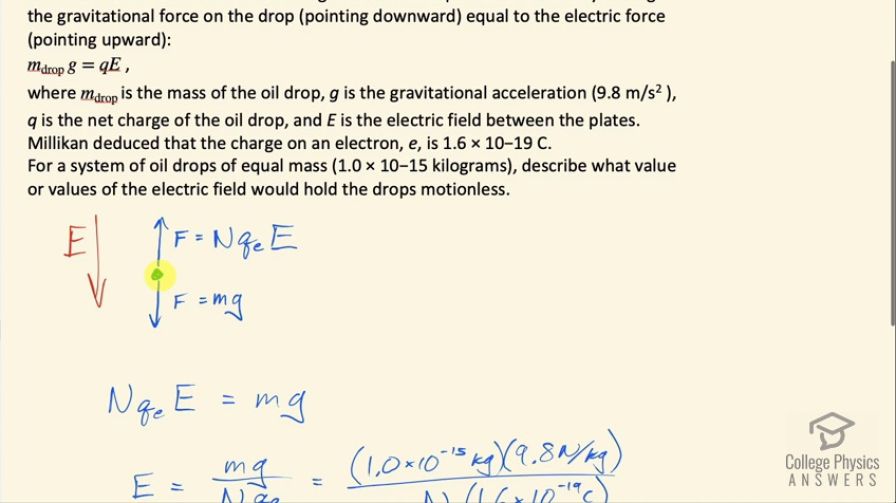Question
In Millikan’s oil drop experiment, he experimented with various voltage differences between two plates to determine what voltage was necessary to hold a drop motionless. He deduced that the charge on the oil drop could be found by setting the gravitational force on the drop (pointing downward) equal to the electric force (pointing upward):
,
where is the mass of the oil drop, is the gravitational
acceleration ( ), is the net charge of the oil drop, and
is the electric field between the plates. Millikan deduced that the charge on an electron, , is .
For a system of oil drops of equal mass (), describe what value or values of the electric field would hold the drops motionless.
Final Answer
Solution video
OpenStax College Physics for AP® Courses, Chapter 30, Problem 2 (Test Prep for AP® Courses)

vote with a rating of
votes with an average rating of
.
Calculator Screenshots
Video Transcript
This is College Physics Answers with Shaun Dychko. The Millikan Oil Drop experiment had a drop of oil that is charged suspended in an electric field and there's going to be weight downwards with a magnitude of mass times gravitational field strength and then there's going to be a force upwards if the electric field is down and the charge is negative on this drop then there's going to be a force upwards equal to the amount of charge which will be the number of extra electrons times the charge per electron—the elementary charge in other words— this total charge gets multiplied by the electric field strength to find the force that is upwards. So this force to the electric field equals the weight downwards and we can solve for the electric field by dividing both sides by the number of extra electrons times the charge per electron. So E then is mg over number of electrons that are extra times elementary charge. So that's 1.0 times 10 to the minus 15 kilograms for the mass of a drop times 9.8 newtons per kilogram— gravitational field strength— divided by 1.6 times 10 to the minus 19 coulombs per charge, this works out to 6.1 times 10 to the 4 newtons per coulomb divided by N, where this N here is different from this N... this N in this part here is the unit and stands for 'Newtons' there but this N in the denominator is a natural number— 1, 2, 3, 4, 5 and so on— it's the number of extra charges or the net number of unbalanced charges that are on this oil drop. So these are the possible electric fields: 6.1 times 10 to the 4 newtons per coulomb divided by some natural number.
